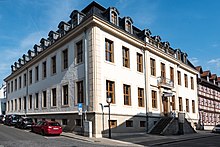Prince Otto Museum
The Fürst Otto Museum Wernigerode was the local history museum in the city of Wernigerode in the Harz from 1897 to 1930 . Parts of its holdings, including those relating to mining in the Harz, were transferred to the collection of today's Harz Museum in Wernigerode . Today the building is used by the Robert Koch Institute .
exhibition
The Fürst Otto Museum had five exhibition rooms in the house, the remaining apartments were rented. The exhibition was divided into a scientific area, an area that concerned the Princes of Stolberg-Wernigerode with their most famous representative, Prince Otto zu Stolberg-Wernigerode , and one that dealt with the history of the city of Wernigerode.
In the natural sciences, the history of the earth in the Harz was presented chronologically using fossils , minerals and rocks. The historical mining in Wernigerode and the surrounding area was also discussed. An ornithological collection provided information about bird species in the Harz Mountains. One room consisted of almost 100 ornate cast iron stove plates , most of which were made in Ilsenburg .
The exhibition also dealt with the history of the city and county of Wernigerode and the dynasty and counts of Stolberg-Wernigerode that ruled over them.
history
The Fürst Otto Museum has been located in the Princely House at Burgstrasse 37 in Wernigerode, today's Robert Koch Institute, since July 31, 1897. After the two-story half-timbered houses at this point burned down during the city fire on June 30, 1751, this stately stone building in the Baroque style was completely rebuilt and significantly more solid within three years - cf. Inscription above the entrance door from 1754. The most famous resident of the building was the war and domain councilor Leopold Friedrich Günther von Göckingk , who became known as a poet and who lived here until 1793. The building was later used until 1876 a. a. used as the seat of the count's government.
During the lifetime of Prince Otto zu Stolberg-Wernigerode, who died in 1896, the scientific assistant teacher Friedrich Bühring, building officer Eduard Messow and the Wernigerode pharmacist Wockowitz inspected a room in this former government building that was being considered for the establishment of a local history museum and found it to be good. In 1895 the archaeologist Paul Höfer and the now grammar school teacher Bühring made further suggestions for the use of the space and confirmed them by Prince Otto. This cleared the way for the founding of a museum, the basis of which a. a. formed the collection of the former cathedral preacher Augustin from Halberstadt and parts of the collections of Count Botho zu Stolberg-Wernigerode, who died in 1881. After the death of his father, Prince Christian-Ernst zu Stolberg-Wernigerode donated a substantial part of the exhibits in 1897 on the condition that the museum should henceforth be called the Fürst-Otto-Museum . The scientific processing of the collections was placed in the hands of Paul Höfer and senior teacher Bühring. After the death of these two founding fathers of the museum, the Fürst Otto Museum was without scientific management for at least five years. The Princely Chamber then took over the museum administration during the First World War and began to redesign the collection around 1924. When Wernigerode Castle was opened as a museum at the end of the 1920s , this meant the final closure of the Fürst Otto Museum in 1930 .
Web links
Individual evidence
- ↑ Collection: "Bergbau im Harz" In: museum-digital.de , accessed on April 4, 2018.
- ↑ a b Dr. Günter Denecke: The Fürst Otto Museum . In: Stadtbaurat Hans Deistel (ed.): Wernigerode city and country - Germany's urban development - city of Wernigerode and the county of Wernigerode with its health resorts Ilsenburg and Schierke . Dari-Verlag, Berlin 1926, p. 43-50 .
Coordinates: 51 ° 49 ′ 55.7 ″ N , 10 ° 47 ′ 22 ″ E
